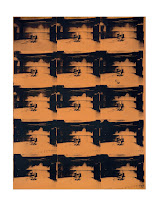Previous lectures covered:
- Representation and reality
- Kitsh
- The Vernacular
- Self reference
- Deconstruction
Today we were bringing these ideas together to think about
Examples of parody, pastiche, satire in visual design as a way of achieving:
- Humour
- Political commentary
- Critique
- Layered understanding/engagement
- Nostalgia
We also be explored and asked questions around the idea of authenticity.
Appropriation: The intentional borrowing, copying, and alteration of pre existing images and objects. It is a strategy that has been used by artists for millennia, but took on new significance in mid 20th century America and Britain with the rise pf consumerism and the proliferation of popular images through mass media outlets from magazines to television.
'Design has always borrowed images from other fields, especially from art and popular culture’
- Rick Poynor
Andy Warhol, Orange Disaster number 5, 1963
Electric chair, final executions happened.
Metaphor for death, through repetition. Reduces it to meaningless.
Waiting for its next victim.
Doesn't have an effect seeing a gruesome picture over and over again.
Repetition is used through art and design, I need to think about how it works as a visual device.
The white stripes - Hardest Button to Button
Uses repetition throughout music video, plays on a similar idea to andy Warhol.
Described as making living people into puppets. Removing humanity from the musicians.
'Vintage' - Appropriated nostalgia -Images
Period, place or a style.
'We look at the present through a rear view mirror, we march backwards into the future.' Marshall.
Marcel Duchamp, 1919. Ready made, Mona Lisa. LHOOQ.
Readymade - A commonplace refabricated object isolated from its functional context and elevated to the status of art by the mere act of an artist's selection. So revered. Religious icon.
Assisted readymade - where slight inverenations have been made to such an object. Challenging conventions.
Banksy: Moona Lisa
Sherrie Levine, Fountain (after marcel champ: A.P), 1991
Inverting, crafted using expensive materials. showing artist innovations, continue to build on achievements of the past.
Sherrie Levine: 'I try to make art which celebrates doubt and uncertainty. Which provokes answers but doesn't give them. Which withholds absolute meaning by incorporating parasite meanings. Which suspends meaning while perpetually dispatching you towards interpretation, urging you beyond dogmatism, beyond doctrine, beyond ideology, beyond authority.'
- Banksy: Show me the monet, 2005. Subtle twist. Abandoned shopping trolley.
- Paula Sher, Swatch, 1985, Herbert Matter, 1935
- Barney Bubbles, Music for pleasure, 1977, Album cover.
- Piet Mondrian (De Stijl) (Style in dutch) Movements in history of visual design.
Pastiche, parody and satire
Sature - A critique or attack, driven by a desire to make a social commentary or to challenge the status quo but which employs humour as its weapon to do this. Makes people smile, but also makes people think.
Pastiche - A form of ‘homage’. Like a parody, it copies or mimics elements of another work's style, sometimes in a humorous way, but usually just as an affectionate nod to another artist's work. It references the original without necessarily making a comment (positive or negative) about it.
Cartoon:
- 1670s, ‘a drawing on strong paper (used as a model for another work)’, from French carton, and from Italian cartone - ’strong, heavy paper, pasteboard,’ thus ‘preliminary sketches made by artists on such paper’.
- Extension to comical drawings in newspapers and magazines is 1843: ‘Punch has the benevolence to announce, that in an early number of his ensuing Volume he will astonish the Parliamentary Committee by the publication of several exquisite designs, to be called Punch's Cartoons!’
 Appropriation can be so layered, re-appropriation enhance the impact of original image.
Appropriation can be so layered, re-appropriation enhance the impact of original image.Jeff Rankin after Shephard Fairy, and re-appropriated version, 2008-17 is an example of re-appropriation. Copycats can create powerful art.



